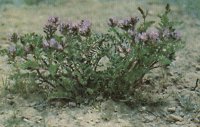LOCOWEED


Description:
Locoweed flowers resemble sweetpeas. Blossoms may be
blue, purple, yellow, or white. Each stem contains
numerous leaves and ends with a leaflet.
Its found
on foothills, plains, and semiarid regions. It grows in tufts or clumps, 4 to 24 inces high. It is a biennial in the pea family.

Horses, cattle, sheep,
and goats are frequently poisoned by eating locoweed.
The plant gets its name from the Spanish word that describes the crazy behavior of poisoned animals.
"Locoed" horses seldom recover completely, so they
have little value as saddle or work animals. Beef
cattle rarely make economic gains, although they may
appear to recover. Calf and lamb losses from abortion
may be high.
Animals ordinarily will not eat
locoweed unless feed is scarce. After eating it, they
may prefer locoweed to good forage. Animals are more
susceptible to locoweed poisoning after they have once
been affected.
The more poisonous species include
white locoweed, purple, blue, Bigbend, and western
locoweed. Loco is poisonous at all stages of growth.
Plants are dangerous throughout the year-even when they have matured and dried. All parts are toxic. Locoweed
loses very little toxicity after three years of
storage.

Where and When It Grows
Locoweed is commonly
found on foothills and plains and in semiarid desert
regions. It starts growth in late fall, in winter, or
in early spring-depending on locality, species, and
moisture.
The purple is found from southwestern
South Dakota south to Texas and New Mexico.
White
grows from Montana and North Dakota south to Arizona,
New Mexico, and Texas.
Blue grows from eastern
Washinton to California, east to Colorado. Bigbend
locoweed is native to the region of Texas for which it
was named; it also occurs in southern New Mexico.
Western locoweed grows in eastern Arizona, as well as
in the same areas as Bigbend.

How It Affects
Livestock
Usually, an animal must eat large
amounts of locoweed for 2 to 5 weeks before death
occurs. Signs of poisoning appear after 2 to 3 weeks of continuous grazing on the plant.
In cows and ewes
with acute poisoning, abortion and congenital skeletal
malformations frequently occur.

Signs of poisoning:
1. Loss of flesh
2. Irregular gait
3. Loss of sense of direction
4. Nervousness
5. Weakness
6. Withdrawal from other animals
7. Loss of
muscular control
8. Violent actions when disturbed.

BACK TO INDEX
H O M E
Would You Consider Signing
My Book?










